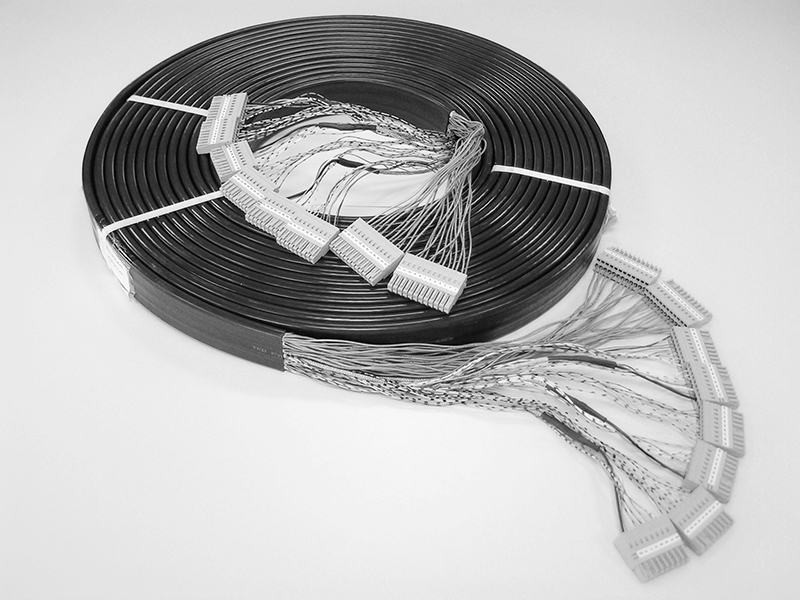Photo: © Kone

News | April 2024
Kone acquires Paca Ascenseurs
Assa Abloy has sold its lift maintenance business Paca ascenseur (Paca) in France to Kone. With this acquisition, Kone intends to strengthen its local presence in the region.

Lift car with cross-section sketch of a typical all-inclusive line (with application-specific function modules in an approximately 6 cm wide flat cable). (Photo: © kalafoto - stock.adobe.com)
January 2020
Whereas in the past switches in the car had to be laboriously wired individually with relays in the control cabinet, modern time-saving bus systems have long since ruled the roost.
Digitalisation and network technology have provided additional technological leaps forward, reflected in even more sophisticated control technology, more speed and travel comfort and any amount of info- and entertainment.
"The trend is towards tailor-made flat cables in which all functionalities are accommodated in a hybrid-design overall cable," emphasised Marc Schneck, key accounter for lift technology at the cable and system provider TKD.
"The decisive factor in designing and producing all-inclusive systems is that adjacently placed function bundles of control, data, bus and network cables are adapted in terms of construction and packing for durability and operational safety. "They not only have to be able to absorb the enormous forces inescapably associated with the unceasing up and down movements of the car, but also ever higher travel speeds. 10 m/s and more are not unusual in lifts.
While classic functions such as lift and door control, distance measurement for positioning of the car in the shaft, ventilation, emergency-off, sensors, car and emergency light as permanent features continue to determine the inner workings of hybrid travelling cables, leading lift manufacturers are demanding even more added value – i.e. more functionality – from the connection lines.
 Aspects like access control, video monitoring, WLAN connection, VoIP and emergency call VoIP and the increasingly popular ‘infotainment’ are what are driving this development. The spectrum here ranges from interactive floor displays and alternating light moods to huge monitor walls – as in cruise ships – on which live pictures of an outdoor camera can be projected. "Entertainment and virtual experience worlds are increasingly becoming a factor - also in lifts," said Schneck.
Aspects like access control, video monitoring, WLAN connection, VoIP and emergency call VoIP and the increasingly popular ‘infotainment’ are what are driving this development. The spectrum here ranges from interactive floor displays and alternating light moods to huge monitor walls – as in cruise ships – on which live pictures of an outdoor camera can be projected. "Entertainment and virtual experience worlds are increasingly becoming a factor - also in lifts," said Schneck.
The new functionalities are implemented via high performance network cables, which are becoming constants in travelling cables for lifts. Modern hybrid cables include up to four different CAT7 elements for the latest network applications – after all, pure infotainment usually has to be separated from critical hardware such as video monitoring or access control systems.
In order to reinforce network cables that would traditionally be at home in an office environment for the movement stress in lift shafts, TKD designers have engaged in targeted retrofitting and special conditioning of the CAT7 composite. This combination of wire insulation, pair shielding and overall screen ensures stress resistance. Combined with low impedance centre conductors, this produces low damping values and optimal EMC protection - also over great distances and vis-a-vis neighbouring energy cables.
"Even over long distances – i.e. at 80 to 100 m suspension height and travel routes of up to 200 m – the cable provides full CAT7 performance," Schneck noted. "What comes in at the front in data and signals also comes out at the back without any losses - quite an achievement given the permanent stress."
Apart from network and bus modules, other bundle or layered strand function blocks made up of data and control lines, which are designed application specifically, dominate the inner workings of the flat cables, which are normally installed and connected in the middle of the lift shaft.
While PVC used to be regarded as a strong sheathing material, the trend is clearly in the direction of halogen-free, self-extinguishing compounds. In the case of suspension heights over 50 m, steel load carriers are reworked into the outer sheathing. They compensate for their greater deadweight and absorb tensile loads in a targeted manner.
Plug&play has long applied to lift construction. Connection-ready cable sets, which are delivered just-in-time directly to the building site in the proper lengths ex works – are in demand in order to save time and costs in installation, explained Schneck. A trend which if anything has become even greater. "Anyone who has crimped and connected CAT7 lines knows how tricky and laborious this procedure is."
Christian Hohnen
The author is marketing director at TKD Kabel GmbH
Write a comment